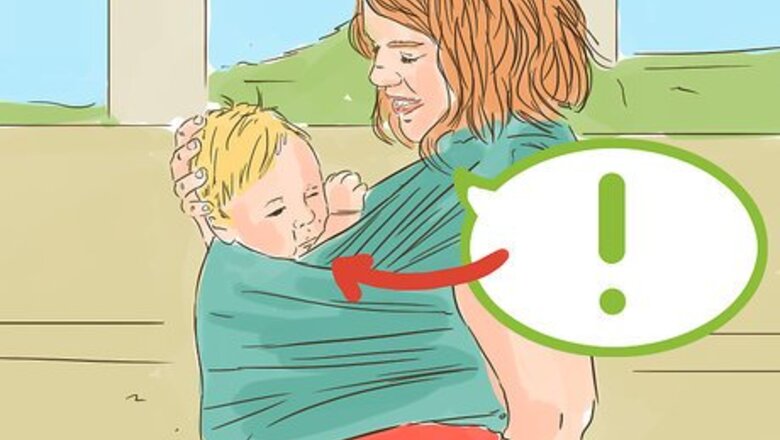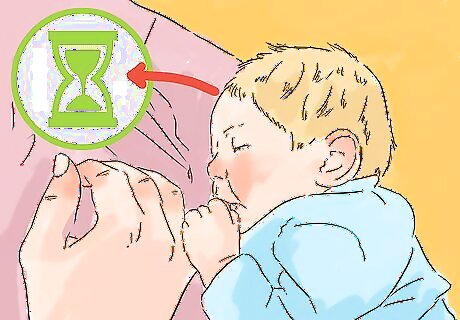
views
Talking to Your Baby

Speak to your baby. Babies are good at listening to human speech. They will begin to understand language before they can actually use it themselves. To ensure your baby learns to copy you by speaking for themselves, talk to your baby regularly. You could talk to your baby about what their doing. For instance, if your baby is playing with a toy, you could say, “That is a nice toy you have,” or “Wow, what a great toy.” Tell your baby simple words like colors, body parts, and names. For instance, when the baby sees something red, say, “That is red.” If the baby points to your hand, say, “That is my hand.” Speak to your baby in an affectionate way. Imitating your baby is another great option! In fact, imitating your baby helps them learn how to imitate you.

Listen to your baby’s response. When your baby sees you listening to them, they will learn to listen when you speak. This will help them socialize the norms of conversation properly. After speaking to your baby, give them time to respond and let them finish vocalizing before responding to your baby. Your baby will not be able to reply with words of their own for many months. However, your baby will try hard to copy your speech and will probably make sounds in reply to your communication. Your baby might, for instance, make sounds like “ooh,” “bah,” or “gaga.”

Repeat key words several times. While it is important to speak to your baby in full sentences and not just baby sounds or one-word sentences, you should reinforce key words within sentences after giving your child the opportunity to respond to your sentences. For instance, you might say, “That is red,” then wait for your child to gurgle a reply. Repeat the word red while pointing at the red object. This will encourage your child to copy you by repeating the word red. If your baby imitates your speech but doesn’t articulate the word correctly, model the appropriate pronunciation while encouraging their efforts. For instance, you could say, “That’s right, this is red! Rrreddd!”

Encourage more complex speech. At 18 months old, you can encourage your baby to imitate more complex speech. For instance, give your baby a plastic toy phone. With your baby’s full attention on you, take your phone out of your bag and say “Hello?” just as you would when answering the phone with a real conversation partner. Have a brief imaginary conversation, then say, “Good-bye.” This will encourage your baby to use their own plastic play phone in the same way.
Modeling Behavior

Show your baby how to play. Play simple games with your baby. For instance, attract your baby’s attention by saying, “Baby, baby, over here!” in a happy and boisterous way. When your baby is looking at you, place both hands on your head. Remove your hands from your head, then put them back on your head several times. By repeating the action, your baby will be encouraged to imitate you. Play peek-a-boo. Use your hands to cover your face, then reveal your face to the baby while saying “Peek-a-boo!” Smile after making your exclamation. Repeat several times so your baby will be inspired to try to imitate you. Touching objects or toys with your hand several times in succession will demonstrate to your baby how their limbs work. They will therefore be equipped to imitate you later by doing the same thing. Choose songs and games that encourage imitation, like “Head, Shoulders, Knees, and Toes” and Simon Says.
Be patient and encouraging. There’s no telling how many times you’ll need to repeat a given action before your baby will imitate you. Some babies are not much interested in playing games with adults. Other babies find great joy in imitating the actions of adults and others in play. If your baby does not catch on right away despite your encouragement, help baby imitate you by moving their hands to the right place on the toy, or moving their hands to their head. Always be gentle when moving your baby and reward their efforts with praise. Play behaviors are best encouraged when your baby is 41 weeks old or older.

Model how to eat. Sit your baby in a high-chair where they are secure. Ensure your baby is looking at you. Take a baby spoon and dip it in a soft pudding or gelatin. Open your mouth wide in an exaggerated and unnatural way. Take a bite of the sweet gelatin or pudding. This model will help your baby copy eating behavior. To test whether or not your baby will actually imitate you after your encouragement, dip a baby spoon into a jar of baby food and bring the spoon close to your baby’s mouth. Your baby should copy your behavior. Try to make friendly, positive facial expression while feeding your baby. If you are dour or grim whilst feeding your baby, they might get the impression that eating is not much fun, and be disinclined to continue imitating you.

Show your baby how to clean. When your baby is 18 months old, they can engage in more complex behaviors like cleaning – if you provide encouragement. Provide your child with a small toy broom so it can imitate your behavior. While your child is watching you, take your own broom and sweep your wood, vinyl, or other smooth floor. Bend over and sweep the dust and crumbs you’ve collected into a dustpan. Dispose of them in the bin.

Use common gestures to with your baby. At 7-8 months old, your baby will be able to copy more complex gestures like clapping. In order to encourage your child to imitate your clapping, clap for your baby. You could clap slow or fast. Whether you choose a fast or slow pace, your baby will probably not be able to copy you exactly. You could also show your baby how to love a doll. Hold a doll with one hand and gently pat their head with the other. Do this several times to encourage your baby to do likewise. (You could choose to make a kind and affectionate remark to the doll, such as “I love you, little doll.”) Then, give the doll to your baby.

Show your child basic body language. At 18 months, you can begin encouraging your baby to imitate simple body language. As in all other forms of imitation encouragement, the trick is to show the behavior you want your baby to imitate, then repeat it several times. For instance, you could encourage your child to wave. When bidding farewell to day-care workers, caretakers, or relatives, place your hand near your head with the palm facing toward the person who is leaving, or who you are taking your leave of. Move the hand back and forth (from side to side) in order to wave goodbye. Encourage your baby to do the same. Say, “Wave goodbye, baby.” You could also encourage your baby to shrug by demonstrating how to shrug. Lift your shoulders and hold them at the highest point possible for a brief moment, then relax them again. You could encourage a more exaggerated shrug by lifting your arms out at your sides with your palms facing up at about shoulder level. Repeat your shrug several times in succession to encourage your baby to try shrugging for themselves.
Adopting Rules for Effective Encouragement

Choose the right time to encourage your baby to imitate you. Your baby cannot imitate you (or anyone else) until they are at least 2 months old. Wait to encourage your baby to imitate you until they are at least 2 months old. Babies can respond to stimuli and interaction, but they cannot actually imitate others until they reach the 2 mark. Any appearance of imitation is merely coincidental. Babies need to use a blend of social, cognitive, and motor skills to be able to successfully imitate others. Some babies are more interested in engaging with you before going to bed at night or after waking up from a nap. Take note of when your baby seems to want to engage with you and initiate interactions then.

Keep the focus on you. When encouraging your baby to imitate you, limit distractions. Turn off the TV and radio. Hide toys and games. Hold the baby in front of you so you are within their line of sight. Avoid things can distract a baby and make it harder to encourage them to imitate you.

Don’t give up. You might not see your child imitating your behavior right away. If your child doesn’t imitate you at first, just model the behavior again. Some children process what they’ve been encouraged to imitate over a period of time and only imitate the behavior later in private, or with playmates. If your baby does not seem interested in imitating you, choose another time to encourage your baby to imitate you.
















Comments
0 comment